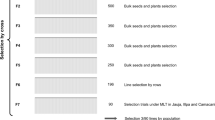Abstract
Saponin-free quinoa genotypes were evaluated in summer and autumn–winter sowings, for phenotypic traits and yield stability. They were obtained by single plant-progeny selection from hybrids, as part of the breeding efforts in adapting the crop to the Brazilian Savannah environments. The soils (Ferralsols) were limed and fertilized prior to cultivation. The experiment was sown in two dates: 20th December 2006 (summer), and 30th April 2007 (autumn–winter), at 15°39′ and 16°14′ S latitude, 47°27′ and 47°44′ W longitude, with altitudes of 976 and 1,110 m, respectively. The mean temperature and rainfall for the summer sowing were 23.0°C and 723 mm. In autumn–winter, under controlled irrigation, the mean temperature was 2.9°C lower than in summer, when plants were exposed to water logging spells. The treatments consisted of fourteen selected genotypes and the varieties Kancolla, BRS Piabiru and Q4.5, used as controls. Comparisons were based on plant height, biomass and grain yield, harvest index (HI) and 1,000 seed weight. The experimental design was a complete randomized bloc, with three replications. Analysis of variance was performed for each sowing and jointly. Statistical differences for the environments were evident only for grain size and plant height. The performance of selected genotypes in each sowing date and in the joint analysis, allows saying that populations Q0779, Q0780 and Q0782 are potentially useful in the acquisition of stable genotypes for the Brazilian Savannahs.
Similar content being viewed by others
References
Alvarez M, Rütte S (1990) Genética. In: Wahli C (ed) Quinua: Hacia su Cultivo Comercial. Latinreco, Quito, Equador, pp 33–60
Bertero DH (2001) Effects of photoperiod, temperature and radiation on the rate of leaf appearance in quinoa (Chenopodium quinoa Willd.) under field conditions. Ann Bot 87(4):495–502
Bertero HD, Vega AJ, Correa G, Jacobsen SE, Mujica A (2004) Genotype and genotype-by-environment interaction effects for grain yield and grain size of quinoa (Chenopodium quinoa Willd.) as revealed by pattern analysis of multi-environment trials. Field Crops Res 89:299–318
Cokerham CC (1980) Random and fixed effects in plant genetics. Theor Appl Genet 56:119–131
Erley GS, Kaul HP, Kruse W, Aufhammer K (2005) Yield and nitrogen utilization efficiency of the pseudocereals amaranth, quinoa, and buckwheat under differing nitrogen fertilization. Eur J Agron 22(1):95–100
Garcia M, Raes D, Jacobsen SE, Michel T (2007) Agroclimatic constraints for rainfed agriculture in the Bolivian Altiplano. J Arid Environ 71:109–121
Geertz S, Raes D, Garcia M, Vacher J, Mamani R, Mendoza J, Huanca R, Morales B, Miranda R, Cusicanqui J, Taboada C (2008) Introducing deficit irrigation to stabilize yields of quinoa (Chenopodium quinoa Willd). Eur J Agron 28(3):427–436
González JA, Gallardo M, Hilal M, Rosa M, Prado FE (2009) Physiological responses of quinoa (Chenopodium quinoa Willd.) to drought and waterlogging stresses: dry matter partitioning. Bot Stud 50:35–42
Jacobsen SE, Mujica A, Jensen CR (2003) The resistance of quinoa (Chenopodium quinoa Willd) to adverse abiotic conditions. Food Rev Int 19(1,2):99–109
Jacobsen SE, Liu F, Jensen CR (2009) Does root-sourced ABA play a role for regulation of stomata under drought in quinoa (Chenopodium quinoa Willd.). Sci Hortic 122:281–287
Mujica-Sanchez A, Jacobsen SE, Izquierdo J, Marathee JP (2001) Quinua (Chenopodium quinoa Willd.): Ancestral Cultivo Andino. Alimento del Presente y del Futuro. FAO, Santiago, Chile
Rea J (1969) Biología floral de la quinua (Chenopodium quinoa). Turrialba, Costa Rica 19:91–96
Santos RLB (1996) Estudos Iniciais para Cultivo de quinoa (Chenopodium quinoa Willd) no Cerrado. M.Sc. Thesis, Universidade de Brasília, Faculdade de Agronomia e Medicina Veterinária, Brasília, Brazil. 129 p
Simmonds NW (1971) The breeding system of Chenopodium quinoa—I. Male sterility. Heredity 27:73–82
Spehar CR (2001) Cruzamentos naturais e variabilidade genética em quinoa (Chenopodium quinoa Willd). In: Simposio de Recursos Genéticos para la América Latina y el Caribe—SIRGEALC 3, 2001, Londrina, PR. Recursos genéticos: conservar para a vida: anais. IAPAR, Londrina; Embrapa Recursos Genéticos e Biotecnologia, Brasília, pp 1–2
Spehar CR (2006) Conquista do Cerrado e consolidação da agropecuária. In: Paterniani E (ed) Ciência, Agricultura e Sociedade. Embrapa Informação Tecnológica, Brasília, DF, pp 195–226
Spehar CR (2007) Quinoa: Alternativa para a Diversificação Agrícola e Alimentar. Planaltina, Embrapa Cerrados, 103 p
Spehar CR, Rocha JES (2009) Effect of sowing density on plant growth and development of quinoa, genotype 4.5, in the Brazilian savannah highlands. Biosci J 25(4):53–58
Spehar CR, Santos RLB (2002) Quinoa (Chenopodium quinoa Willd) BRS Piabiru alternative for crop diversification. Pesqui Agropecu Bras 37(6):889–893
Spehar CR, Santos RLB (2005) Agronomic performance of quinoa selected in the Brazilian Savannah. Pesqui Agropecu Bras 40(6):609–612
Spehar CR, Souza PIM (1993) Adapting the quinoa (Chenopodium quinoa Willd) to cultivation in the Brazilian Highlands: preliminary results. Pesqui Agropecu Bras 28(5):635–639
Utset A, Cid G (2001) Soil penetrometer resistance spatial variability in a Ferralsol at several soil moisture conditions. Soil Tillage Res 61(3–4):193–202
Acknowledgments
The authors want to express their sincere gratitude to the National Research and Development Council (CNPq), and the Coordination for the Improvement of Higher Education Personnel (CAPES), for financial support; the agronomists Sebastião Conrado de Andrade and Alberto Luiz Wanderley, of Dom Bosco and Moça Terra Farms, for their help in conducting experimentation.
Author information
Authors and Affiliations
Corresponding author
Rights and permissions
About this article
Cite this article
Spehar, C.R., da Silva Rocha, J.E. Exploiting genotypic variability from low-altitude Brazilian Savannah-adapted Chenopodium quinoa . Euphytica 175, 13–21 (2010). https://doi.org/10.1007/s10681-010-0154-7
Received:
Accepted:
Published:
Issue Date:
DOI: https://doi.org/10.1007/s10681-010-0154-7




